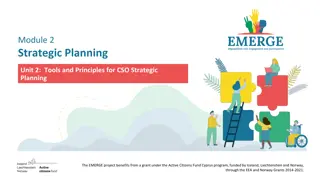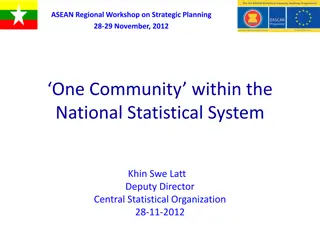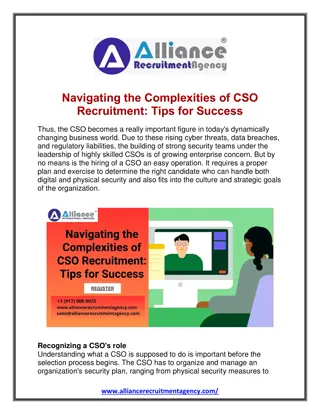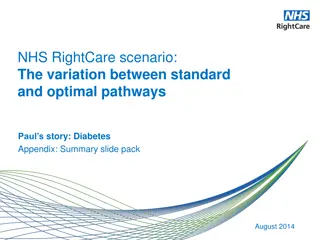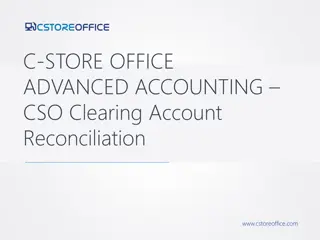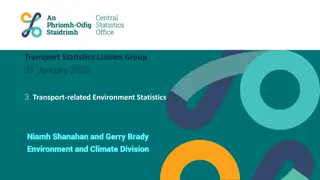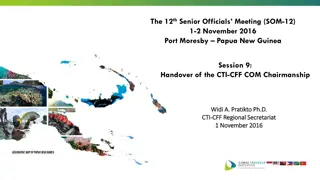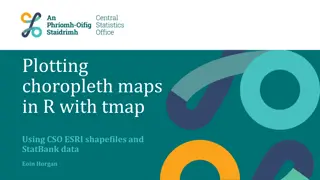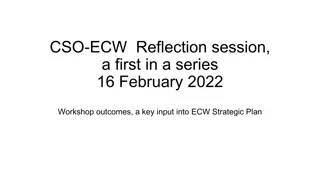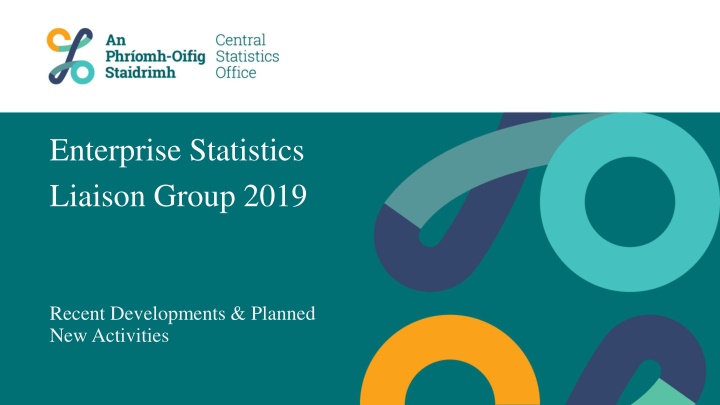
Gender Balance in Business: Statistics and Surveys 2019
Explore the latest developments and statistics on gender balance in business, including insights from the Gender Balance in Business Survey 2019 in Ireland. Discover details on CEO representation, senior executive roles, and more. Get updates on surveys like the Structure of Earnings Survey 2018 in the EU. Stay informed on gender representation in the corporate world.
Download Presentation

Please find below an Image/Link to download the presentation.
The content on the website is provided AS IS for your information and personal use only. It may not be sold, licensed, or shared on other websites without obtaining consent from the author. If you encounter any issues during the download, it is possible that the publisher has removed the file from their server.
You are allowed to download the files provided on this website for personal or commercial use, subject to the condition that they are used lawfully. All files are the property of their respective owners.
The content on the website is provided AS IS for your information and personal use only. It may not be sold, licensed, or shared on other websites without obtaining consent from the author.
E N D
Presentation Transcript
Enterprise Statistics Liaison Group 2019 Recent Developments & Planned New Activities
Business Statistics 1. Developments in the past year 2. New EU Developments planned 3. Update on the Framework Regulation on Business Statistics
New Developments in Business Surveys in 2019 Gender Balance in Business Survey Structure of Earnings Survey Timeliness and Campaign Management
Gender Balance in Business 2019 The Gender Balance in Business Survey 2019 provides the first official statistics from the CSO on gender representation in Senior Executive teams and Boards of Directors of large enterprises in Ireland. The survey was conducted in response to the Balance for Better Business initiative and it aims to provide benchmark information on gender representation. The survey was collected by the CSO between February and April 2019. The online questionnaire asked for the gender breakdown of the Senior Executive team and Boards of Directors. The scope of the survey is large enterprises (i.e. those with over 250 employees). 600 enterprises - response was 55%.
Gender Balance in Business 2019 Only one in nine CEOs in Ireland were women Gender breakdown by senior roles in business, 2019 Male Female % % Chairpersons 92.6 7.4 Boards of Directors 80.4 19.6 Chief Executive Officers (CEOs) 88.5 11.5 Senior Executives 71.7 28.3
Structure of Earnings Survey 2018 EU Requirement Post out November 2019 Last conducted in 2007 as the National Employment Survey The Structure of earnings survey, abbreviated as SES, is conducted every four years in the Member States of the European Union (EU) and provides comparable information at EU level on relationships between the level of earnings, individual characteristics of employees (sex, age, occupation, length of service, educational level) and their employer (economic activity, size of the enterprise, etc).
Structure of Earnings Survey 2018 After 2009 SES statistics on earnings were based on administrative data sources. The primary data source was the Revenue Commissioner s P35 dataset of employee annual earnings which was linked to CSO and other data to provide demographic breakdowns of earnings similar to those previously provided by the National Employment Survey (NES). However, this data did not replicate all of the tables available from the former NES; nor did it contain any breakdown of hours worked or hourly earnings
Proportion of low wage earners in the EU, by sex, age groups, level of Proportion of low wage earners in the EU, by sex, age groups, level of education and type of contract, 2014 education and type of contract, 2014
Business Based Social Surveys 1. Structure of Earnings Survey to be repeated annually. 2. 2020 Job Vacancy Survey Quarterly & follow-up Annual Occupational Breakdown Survey 3. Continuing Vocational Training Survey 2020 collected in 2021
Continuing Vocational Training Survey CVTS 2020 (2021) The Continuing Vocational Training Survey (CVTS) is an enterprise survey which is part of the EU statistics on lifelong learning. The survey covers the following topics: Continuing vocational training, skills supply and demand, training needs Measurement of the form, content and volume of continuing training The enterprises own training resources and the use of external training providers The costs of continuing training Initial vocational training
Continuing Vocational Training Survey CVTS 2020 (2021) + OECD Employer Module on Skills Gaps - piggy back onto the CVTS Key Results in 2015 77% of all enterprises provided training 50% of staff attended training courses 19.4 hours per employee spent on training courses Training course costs equal 2.2% of total labour costs One half of enterprises assess the outcomes of their training activities
Community Innovation Survey The Community Innovation Survey (CIS) is a survey of innovation activities of enterprises in Ireland and other EU Member States. The survey collects information about product and process innovation, as well as organisational and marketing innovations and other key variables during the three year period 2016 to 2018 inclusive. Most questions cover new or significantly improved goods or services or the implementation of new or significantly improved processes, logistics or distribution methods.
Community Innovation Survey 2016 Key Results Total spending on innovation activities in Ireland during 2016 increased by almost 22% to 4.6 billion Industrial enterprises spending on machinery, equipment and software accounted for a quarter of total innovation expenditure Foreign enterprises accounted for 64% of total innovation expenditure 66% of large enterprises had innovation expenditure in 2014-2016 compared with 36% of SMEs Over 43% of foreign owned enterprises had innovation expenditure 57% of all enterprises were innovation active during 2014-2016 Nearly 31% of enterprises were engaged in process innovations, with 29% engaged in product innovations Almost two thirds of large enterprises introduced an organisational innovation
Community Innovation Survey 2018 In the field since 3rdweek of August Piloting a new electronic questionnaire EQ Response rate after 14 weeks 51% - 1 further reminder to issue (54%) 2018 - 29 weeks data collection - response rate 65% Campaign Management - cut data collection to 19 weeks - response target 60% Deadline Eurostat June 2020 Publication April 2020
Campaign Management Improve the management of surveys in the field Improve response - quality - timeliness Reduce time-lag in the field - annual surveys CIS - 2 months less in the field ICT Survey - improved response and reduced timeframe for publication by 2 months - October 2019 (December 2018) Annual Services Inquiry - collection period 2 months shorter
Business Expenditure in Research & Development 2020 The Business Expenditure on Research and Development (BERD) Survey is a survey of the research and development activities of enterprises in Ireland and other EU Member States. The BERD Survey is a targeted survey which is issued to all enterprises which are believed to be actively engaged in research and development Most questions gather information on the spending and performance of research and development. Research and Development (R&D) is creative work undertaken on a systematic basis in order to create new or improved products, processes, services or other applications. R&D is distinguishable from other activities by the presence of an appreciable element of novelty and by the resolution of problems and uncertainties using scientific or technological means. Routine activities, such as routine software development, routine monitoring/analysis or pre-production preparation, where there is no appreciable novelty or problem resolution, are not considered to be R&D for the purpose of this survey.
R&D spend by enterprises increased by 24% from 2015 to 2017 Large enterprises share of R&D expenditure at 63% in 2017 Labour Costs accounted for 60% of all R&D expenditure
69% of total R&D expenditure was by Foreign owned enterprises The largest 100 enterprises in terms of R&D spend accounted for almost 75% of the total R&D expenditure Services sector accounted for 55% of total R&D expenditure 82% of funding for R&D expenditure came from enterprises' own funds Nearly 1,800 enterprises engaged in R&D activities in Ireland in 2017 Ireland ranked 13thin EU28 in terms of R&D intensity in 2015
Development of Services Statistics Monthly Services Inquiry - monthly services value index (MSI) monitors trends in output at current prices of enterprises in the non-financial traded services sector. This is the first step in the development of a Services Production Index that measures gross value added changes at constant prices, i.e. a volume index. Volume Index - deflate turnover to measure the monthly changes of the price adjusted output of the services.
Framework Regulation Integration of Business Statistics - FRIBS Basic Act (Framework Regulation) - adopted this month General Implementing Act - under discussion & to be finalised middle of next year Implementation Jan/Qtr 1 2021 (2022 Trade) Actively planning for implementation
Key Changes for Business Statistics Volume Index in Services Global Value Chains 2021 (pilot) 2024 Extension to coverage ASI - Health, Education & Culture Rebase Reference 2020 to 2021 and return to 0/5 intervals Shorter EU transmission deadlines Minor changes in variables new/breakdowns/renaming minor in nature Services Producer Price Index further development Commercial Real Estate Indictors pilots

